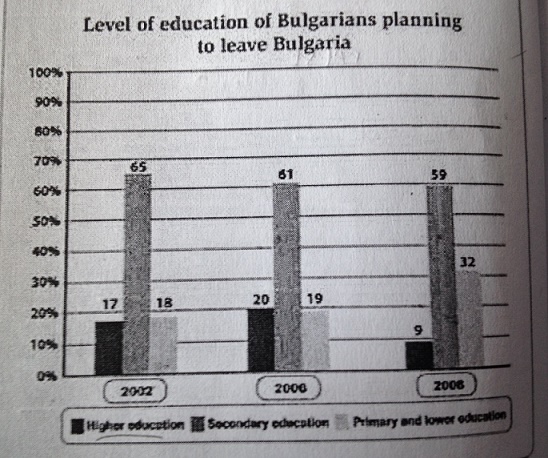Q: The chart below gives information about the level of education of Bulgarian people who wanted to go and live in another country in 2002, 2006, and 2008.
A breakdown of the education levels of Bulgarian citizens who want to go and live overseas in 2002, 2006, and 2008 is illustrated by the presented bar chart. Overall, it is obviously seen that among three levels, including (higher education, secondary education, and primary and lower education), the secondary education students tended to leave their nation, while the others saw low figure over six years.
According to the chart, in 2002, the rate of people with secondary education level stood at two-thirds and became the highest data. This trend declined slightly in the following four and six year to 61 % and 59 % respectively. In addition, at the beginning of the period, the higher education started at 17 percent and in the next four year experienced a marginal rise of three percent. Interestingly, 2008 witnessed a dramatic two-time decrease to nine percent in the end of the period.
However, the proportion of primary and lower education was eight teen per cent in 2002. Even though in 2008, the dramatic rise occurred up to reach 32 %, though this percentage was merely a half as many as the secondary education.
A breakdown of the education levels of Bulgarian citizens who want to go and live overseas in 2002, 2006, and 2008 is illustrated by the presented bar chart. Overall, it is obviously seen that among three levels, including (higher education, secondary education, and primary and lower education), the secondary education students tended to leave their nation, while the others saw low figure over six years.
According to the chart, in 2002, the rate of people with secondary education level stood at two-thirds and became the highest data. This trend declined slightly in the following four and six year to 61 % and 59 % respectively. In addition, at the beginning of the period, the higher education started at 17 percent and in the next four year experienced a marginal rise of three percent. Interestingly, 2008 witnessed a dramatic two-time decrease to nine percent in the end of the period.
However, the proportion of primary and lower education was eight teen per cent in 2002. Even though in 2008, the dramatic rise occurred up to reach 32 %, though this percentage was merely a half as many as the secondary education.

level_education_bulg.jpg
